EC201 Microeconomics Assignment Solutions, NUI Galway, 2019
VerifiedAdded on 2023/01/20
|9
|2050
|88
Homework Assignment
AI Summary
This document presents a comprehensive solution to an EC201 Microeconomics assignment. The solution addresses various microeconomic concepts, including consumer choice, indifference curves, and the assumptions underlying consumer behavior. It analyzes the impact of taxation on complementary goods like cigarettes and alcohol, exploring the concept of cross-price elasticity of demand. The assignment delves into the marginal rate of substitution and consumer equilibrium, illustrated with graphical representations. It also covers production functions, isoquants, and cost minimization strategies for firms. Furthermore, the solution examines market failures, particularly in the context of veterinary services, and discusses the characteristics of public goods, specifically climate change, and the application of rational choice theory. The role of behavioral economics in understanding climate change is also analyzed. Finally, it explores the impact of meat consumption on climate change and the potential use of economic instruments to influence consumption patterns. The solution includes relevant references to support the arguments presented.
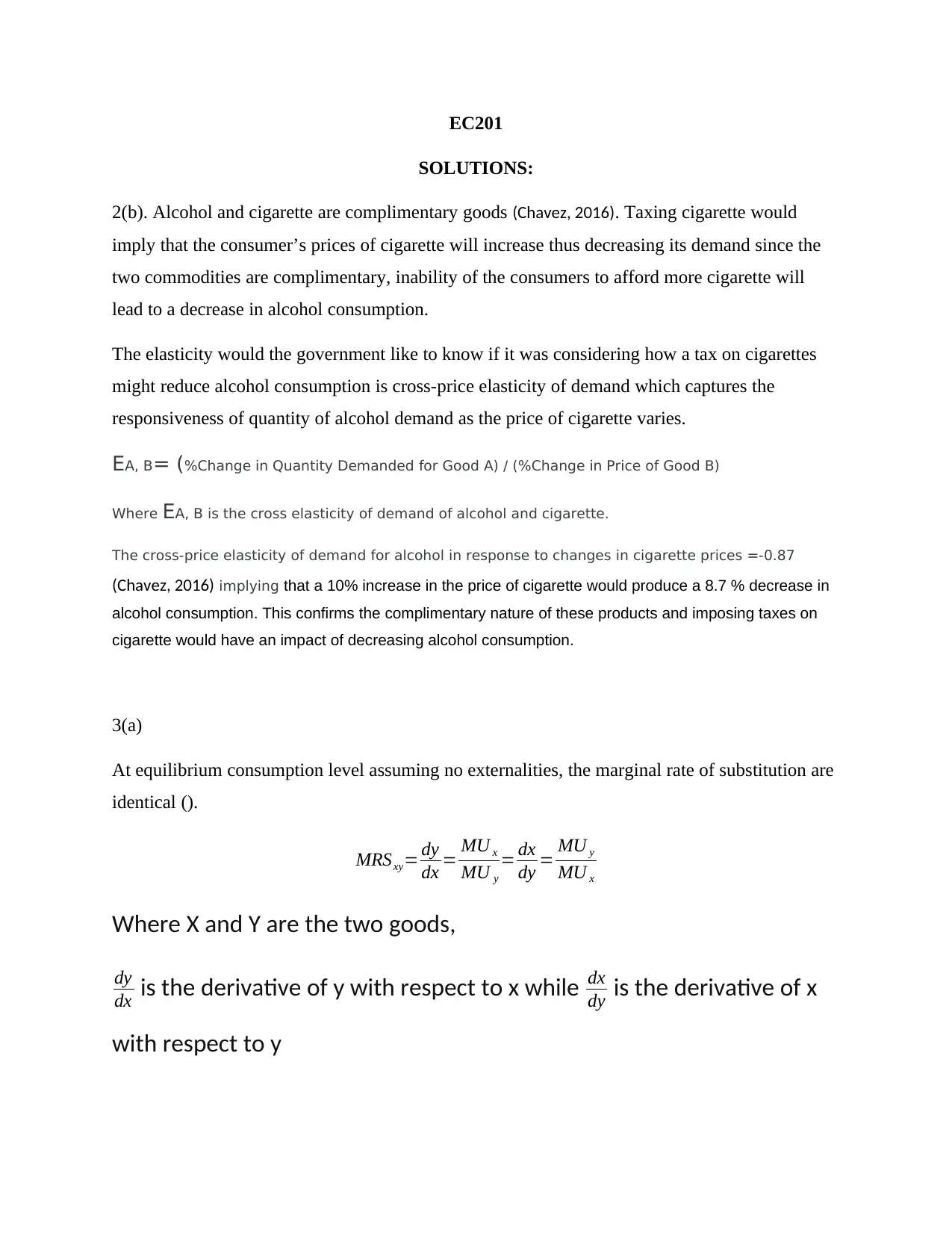
EC201
SOLUTIONS:
2(b). Alcohol and cigarette are complimentary goods (Chavez, 2016). Taxing cigarette would
imply that the consumer’s prices of cigarette will increase thus decreasing its demand since the
two commodities are complimentary, inability of the consumers to afford more cigarette will
lead to a decrease in alcohol consumption.
The elasticity would the government like to know if it was considering how a tax on cigarettes
might reduce alcohol consumption is cross-price elasticity of demand which captures the
responsiveness of quantity of alcohol demand as the price of cigarette varies.
EA, B= (%Change in Quantity Demanded for Good A) / (%Change in Price of Good B)
Where EA, B is the cross elasticity of demand of alcohol and cigarette.
The cross-price elasticity of demand for alcohol in response to changes in cigarette prices =-0.87
(Chavez, 2016) implying that a 10% increase in the price of cigarette would produce a 8.7 % decrease in
alcohol consumption. This confirms the complimentary nature of these products and imposing taxes on
cigarette would have an impact of decreasing alcohol consumption.
3(a)
At equilibrium consumption level assuming no externalities, the marginal rate of substitution are
identical ().
MRSxy= dy
dx = MU x
MU y
= dx
dy = MU y
MU x
Where X and Y are the two goods,
dy
dx is the derivative of y with respect to x while dx
dy is the derivative of x
with respect to y
SOLUTIONS:
2(b). Alcohol and cigarette are complimentary goods (Chavez, 2016). Taxing cigarette would
imply that the consumer’s prices of cigarette will increase thus decreasing its demand since the
two commodities are complimentary, inability of the consumers to afford more cigarette will
lead to a decrease in alcohol consumption.
The elasticity would the government like to know if it was considering how a tax on cigarettes
might reduce alcohol consumption is cross-price elasticity of demand which captures the
responsiveness of quantity of alcohol demand as the price of cigarette varies.
EA, B= (%Change in Quantity Demanded for Good A) / (%Change in Price of Good B)
Where EA, B is the cross elasticity of demand of alcohol and cigarette.
The cross-price elasticity of demand for alcohol in response to changes in cigarette prices =-0.87
(Chavez, 2016) implying that a 10% increase in the price of cigarette would produce a 8.7 % decrease in
alcohol consumption. This confirms the complimentary nature of these products and imposing taxes on
cigarette would have an impact of decreasing alcohol consumption.
3(a)
At equilibrium consumption level assuming no externalities, the marginal rate of substitution are
identical ().
MRSxy= dy
dx = MU x
MU y
= dx
dy = MU y
MU x
Where X and Y are the two goods,
dy
dx is the derivative of y with respect to x while dx
dy is the derivative of x
with respect to y
Paraphrase This Document
Need a fresh take? Get an instant paraphrase of this document with our AI Paraphraser
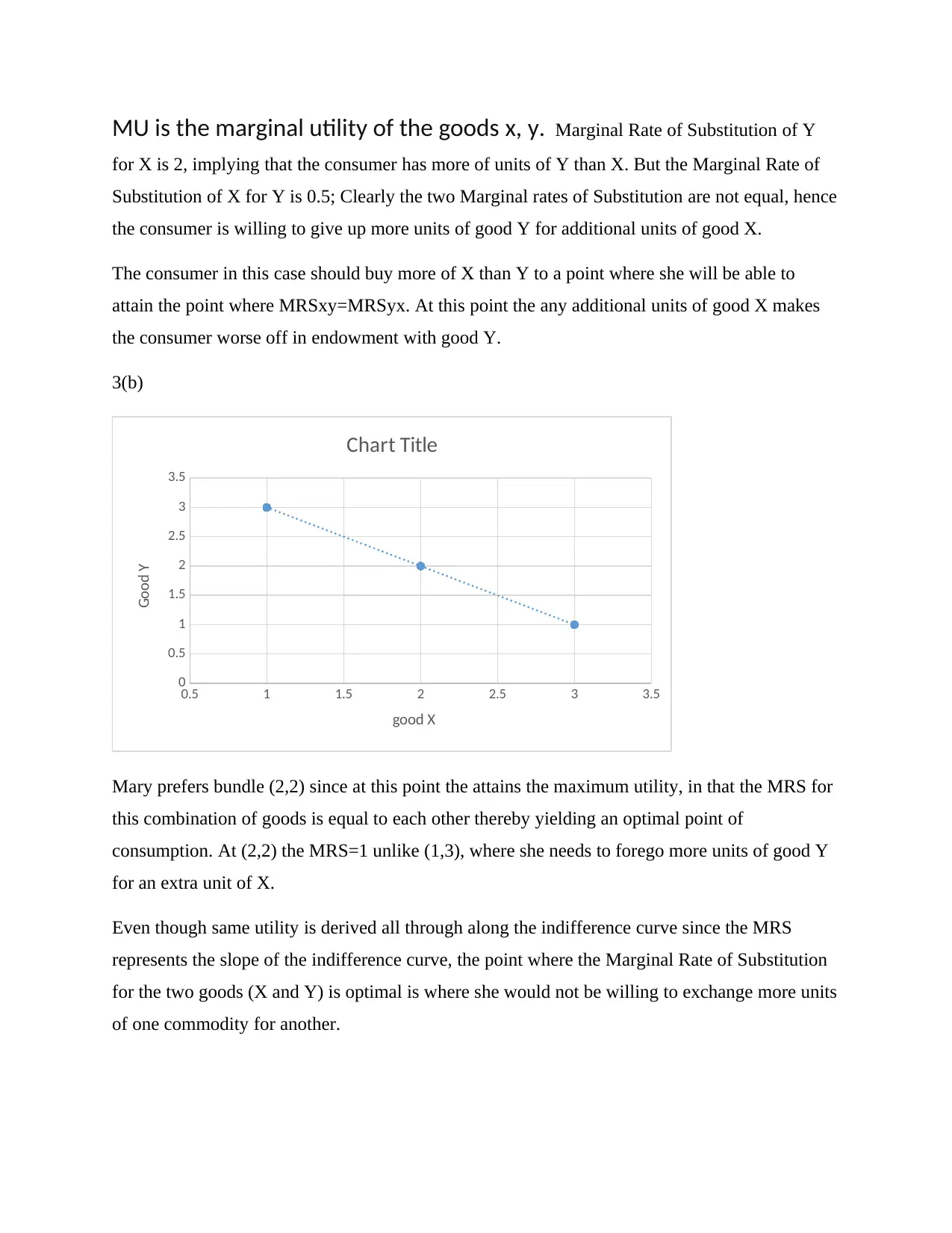
MU is the marginal utility of the goods x, y. Marginal Rate of Substitution of Y
for X is 2, implying that the consumer has more of units of Y than X. But the Marginal Rate of
Substitution of X for Y is 0.5; Clearly the two Marginal rates of Substitution are not equal, hence
the consumer is willing to give up more units of good Y for additional units of good X.
The consumer in this case should buy more of X than Y to a point where she will be able to
attain the point where MRSxy=MRSyx. At this point the any additional units of good X makes
the consumer worse off in endowment with good Y.
3(b)
0.5 1 1.5 2 2.5 3 3.5
0
0.5
1
1.5
2
2.5
3
3.5
Chart Title
good X
Good Y
Mary prefers bundle (2,2) since at this point the attains the maximum utility, in that the MRS for
this combination of goods is equal to each other thereby yielding an optimal point of
consumption. At (2,2) the MRS=1 unlike (1,3), where she needs to forego more units of good Y
for an extra unit of X.
Even though same utility is derived all through along the indifference curve since the MRS
represents the slope of the indifference curve, the point where the Marginal Rate of Substitution
for the two goods (X and Y) is optimal is where she would not be willing to exchange more units
of one commodity for another.
for X is 2, implying that the consumer has more of units of Y than X. But the Marginal Rate of
Substitution of X for Y is 0.5; Clearly the two Marginal rates of Substitution are not equal, hence
the consumer is willing to give up more units of good Y for additional units of good X.
The consumer in this case should buy more of X than Y to a point where she will be able to
attain the point where MRSxy=MRSyx. At this point the any additional units of good X makes
the consumer worse off in endowment with good Y.
3(b)
0.5 1 1.5 2 2.5 3 3.5
0
0.5
1
1.5
2
2.5
3
3.5
Chart Title
good X
Good Y
Mary prefers bundle (2,2) since at this point the attains the maximum utility, in that the MRS for
this combination of goods is equal to each other thereby yielding an optimal point of
consumption. At (2,2) the MRS=1 unlike (1,3), where she needs to forego more units of good Y
for an extra unit of X.
Even though same utility is derived all through along the indifference curve since the MRS
represents the slope of the indifference curve, the point where the Marginal Rate of Substitution
for the two goods (X and Y) is optimal is where she would not be willing to exchange more units
of one commodity for another.
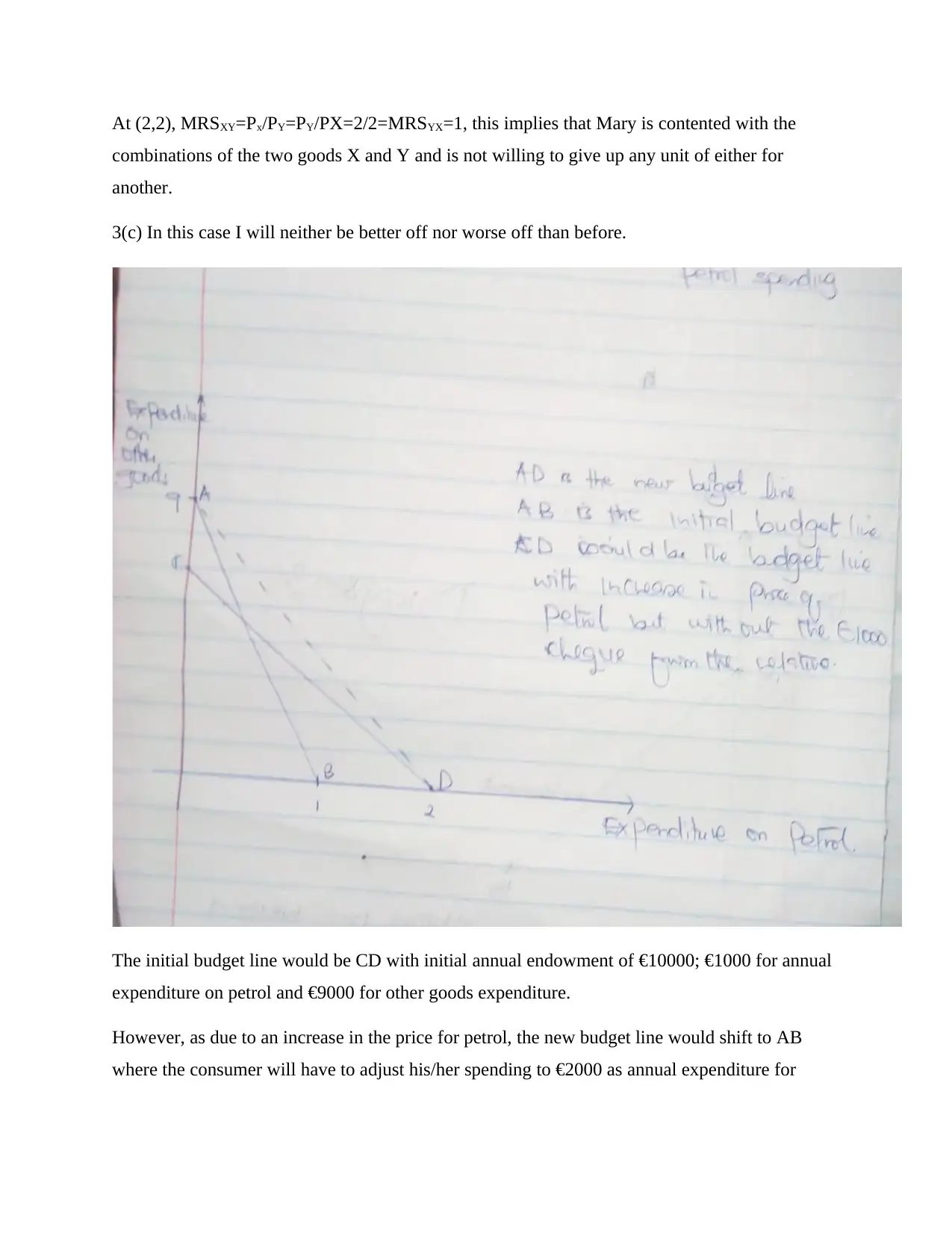
At (2,2), MRSXY=Px/PY=PY/PX=2/2=MRSYX=1, this implies that Mary is contented with the
combinations of the two goods X and Y and is not willing to give up any unit of either for
another.
3(c) In this case I will neither be better off nor worse off than before.
The initial budget line would be CD with initial annual endowment of €10000; €1000 for annual
expenditure on petrol and €9000 for other goods expenditure.
However, as due to an increase in the price for petrol, the new budget line would shift to AB
where the consumer will have to adjust his/her spending to €2000 as annual expenditure for
combinations of the two goods X and Y and is not willing to give up any unit of either for
another.
3(c) In this case I will neither be better off nor worse off than before.
The initial budget line would be CD with initial annual endowment of €10000; €1000 for annual
expenditure on petrol and €9000 for other goods expenditure.
However, as due to an increase in the price for petrol, the new budget line would shift to AB
where the consumer will have to adjust his/her spending to €2000 as annual expenditure for
⊘ This is a preview!⊘
Do you want full access?
Subscribe today to unlock all pages.

Trusted by 1+ million students worldwide
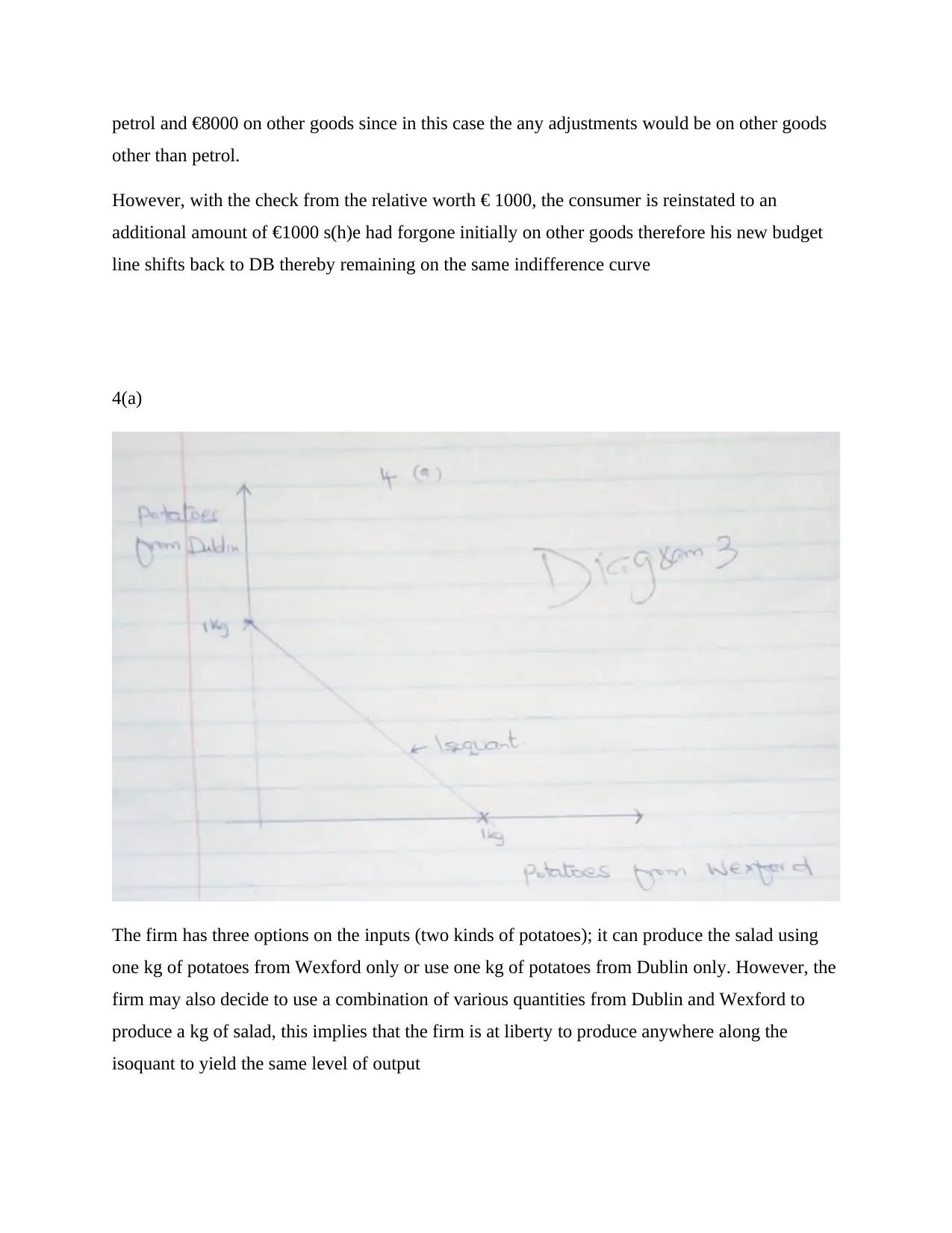
petrol and €8000 on other goods since in this case the any adjustments would be on other goods
other than petrol.
However, with the check from the relative worth € 1000, the consumer is reinstated to an
additional amount of €1000 s(h)e had forgone initially on other goods therefore his new budget
line shifts back to DB thereby remaining on the same indifference curve
4(a)
The firm has three options on the inputs (two kinds of potatoes); it can produce the salad using
one kg of potatoes from Wexford only or use one kg of potatoes from Dublin only. However, the
firm may also decide to use a combination of various quantities from Dublin and Wexford to
produce a kg of salad, this implies that the firm is at liberty to produce anywhere along the
isoquant to yield the same level of output
other than petrol.
However, with the check from the relative worth € 1000, the consumer is reinstated to an
additional amount of €1000 s(h)e had forgone initially on other goods therefore his new budget
line shifts back to DB thereby remaining on the same indifference curve
4(a)
The firm has three options on the inputs (two kinds of potatoes); it can produce the salad using
one kg of potatoes from Wexford only or use one kg of potatoes from Dublin only. However, the
firm may also decide to use a combination of various quantities from Dublin and Wexford to
produce a kg of salad, this implies that the firm is at liberty to produce anywhere along the
isoquant to yield the same level of output
Paraphrase This Document
Need a fresh take? Get an instant paraphrase of this document with our AI Paraphraser
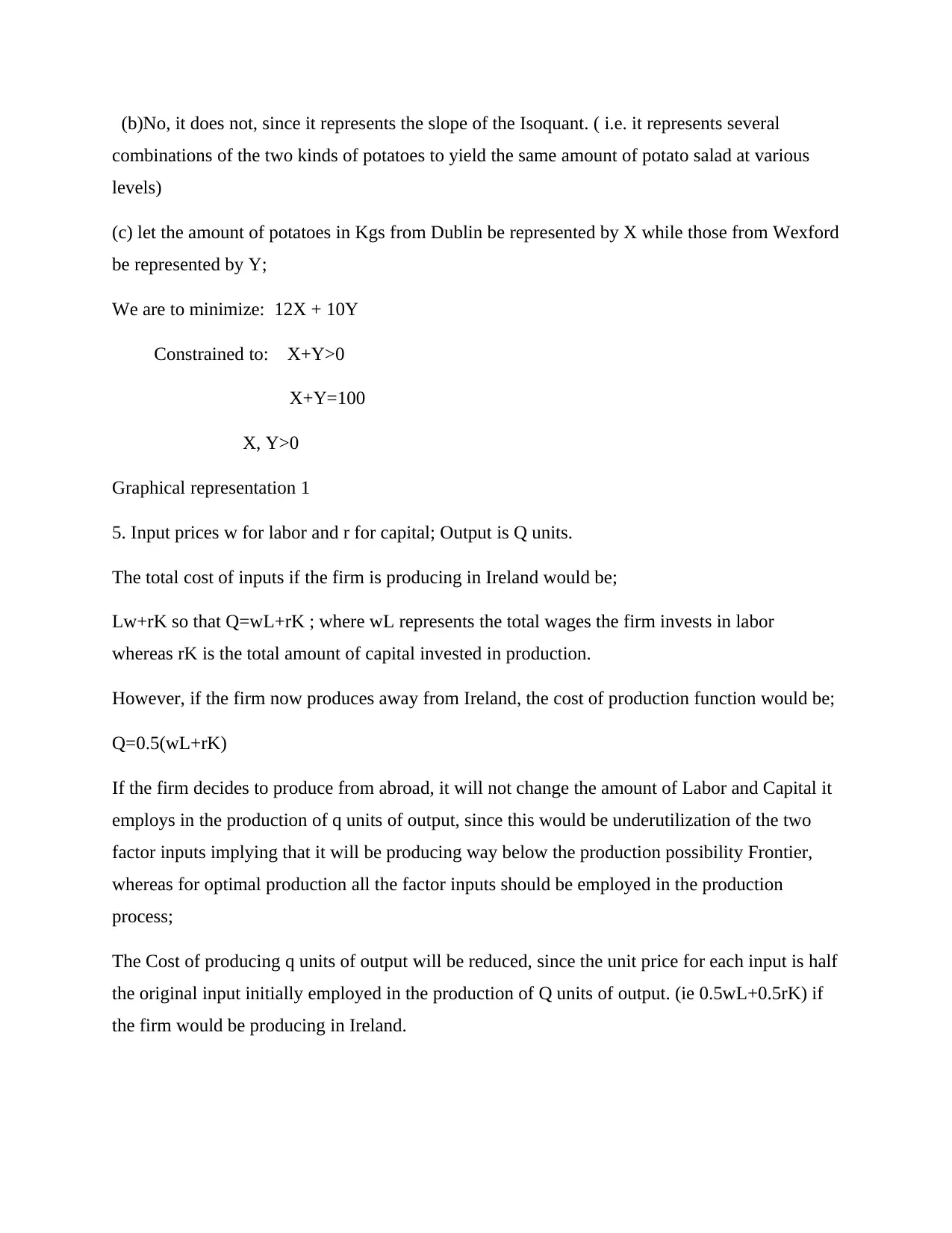
(b)No, it does not, since it represents the slope of the Isoquant. ( i.e. it represents several
combinations of the two kinds of potatoes to yield the same amount of potato salad at various
levels)
(c) let the amount of potatoes in Kgs from Dublin be represented by X while those from Wexford
be represented by Y;
We are to minimize: 12X + 10Y
Constrained to: X+Y>0
X+Y=100
X, Y>0
Graphical representation 1
5. Input prices w for labor and r for capital; Output is Q units.
The total cost of inputs if the firm is producing in Ireland would be;
Lw+rK so that Q=wL+rK ; where wL represents the total wages the firm invests in labor
whereas rK is the total amount of capital invested in production.
However, if the firm now produces away from Ireland, the cost of production function would be;
Q=0.5(wL+rK)
If the firm decides to produce from abroad, it will not change the amount of Labor and Capital it
employs in the production of q units of output, since this would be underutilization of the two
factor inputs implying that it will be producing way below the production possibility Frontier,
whereas for optimal production all the factor inputs should be employed in the production
process;
The Cost of producing q units of output will be reduced, since the unit price for each input is half
the original input initially employed in the production of Q units of output. (ie 0.5wL+0.5rK) if
the firm would be producing in Ireland.
combinations of the two kinds of potatoes to yield the same amount of potato salad at various
levels)
(c) let the amount of potatoes in Kgs from Dublin be represented by X while those from Wexford
be represented by Y;
We are to minimize: 12X + 10Y
Constrained to: X+Y>0
X+Y=100
X, Y>0
Graphical representation 1
5. Input prices w for labor and r for capital; Output is Q units.
The total cost of inputs if the firm is producing in Ireland would be;
Lw+rK so that Q=wL+rK ; where wL represents the total wages the firm invests in labor
whereas rK is the total amount of capital invested in production.
However, if the firm now produces away from Ireland, the cost of production function would be;
Q=0.5(wL+rK)
If the firm decides to produce from abroad, it will not change the amount of Labor and Capital it
employs in the production of q units of output, since this would be underutilization of the two
factor inputs implying that it will be producing way below the production possibility Frontier,
whereas for optimal production all the factor inputs should be employed in the production
process;
The Cost of producing q units of output will be reduced, since the unit price for each input is half
the original input initially employed in the production of Q units of output. (ie 0.5wL+0.5rK) if
the firm would be producing in Ireland.
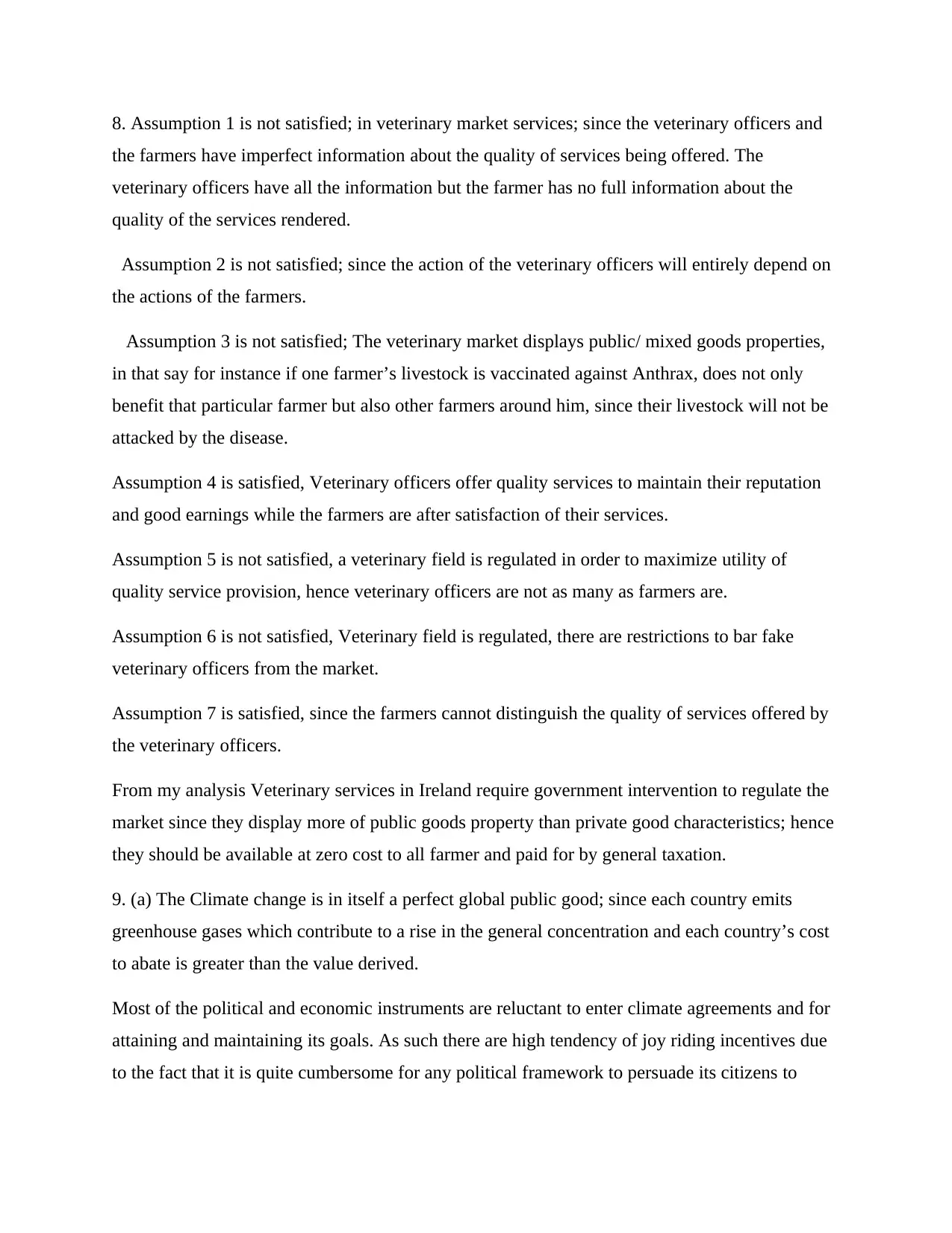
8. Assumption 1 is not satisfied; in veterinary market services; since the veterinary officers and
the farmers have imperfect information about the quality of services being offered. The
veterinary officers have all the information but the farmer has no full information about the
quality of the services rendered.
Assumption 2 is not satisfied; since the action of the veterinary officers will entirely depend on
the actions of the farmers.
Assumption 3 is not satisfied; The veterinary market displays public/ mixed goods properties,
in that say for instance if one farmer’s livestock is vaccinated against Anthrax, does not only
benefit that particular farmer but also other farmers around him, since their livestock will not be
attacked by the disease.
Assumption 4 is satisfied, Veterinary officers offer quality services to maintain their reputation
and good earnings while the farmers are after satisfaction of their services.
Assumption 5 is not satisfied, a veterinary field is regulated in order to maximize utility of
quality service provision, hence veterinary officers are not as many as farmers are.
Assumption 6 is not satisfied, Veterinary field is regulated, there are restrictions to bar fake
veterinary officers from the market.
Assumption 7 is satisfied, since the farmers cannot distinguish the quality of services offered by
the veterinary officers.
From my analysis Veterinary services in Ireland require government intervention to regulate the
market since they display more of public goods property than private good characteristics; hence
they should be available at zero cost to all farmer and paid for by general taxation.
9. (a) The Climate change is in itself a perfect global public good; since each country emits
greenhouse gases which contribute to a rise in the general concentration and each country’s cost
to abate is greater than the value derived.
Most of the political and economic instruments are reluctant to enter climate agreements and for
attaining and maintaining its goals. As such there are high tendency of joy riding incentives due
to the fact that it is quite cumbersome for any political framework to persuade its citizens to
the farmers have imperfect information about the quality of services being offered. The
veterinary officers have all the information but the farmer has no full information about the
quality of the services rendered.
Assumption 2 is not satisfied; since the action of the veterinary officers will entirely depend on
the actions of the farmers.
Assumption 3 is not satisfied; The veterinary market displays public/ mixed goods properties,
in that say for instance if one farmer’s livestock is vaccinated against Anthrax, does not only
benefit that particular farmer but also other farmers around him, since their livestock will not be
attacked by the disease.
Assumption 4 is satisfied, Veterinary officers offer quality services to maintain their reputation
and good earnings while the farmers are after satisfaction of their services.
Assumption 5 is not satisfied, a veterinary field is regulated in order to maximize utility of
quality service provision, hence veterinary officers are not as many as farmers are.
Assumption 6 is not satisfied, Veterinary field is regulated, there are restrictions to bar fake
veterinary officers from the market.
Assumption 7 is satisfied, since the farmers cannot distinguish the quality of services offered by
the veterinary officers.
From my analysis Veterinary services in Ireland require government intervention to regulate the
market since they display more of public goods property than private good characteristics; hence
they should be available at zero cost to all farmer and paid for by general taxation.
9. (a) The Climate change is in itself a perfect global public good; since each country emits
greenhouse gases which contribute to a rise in the general concentration and each country’s cost
to abate is greater than the value derived.
Most of the political and economic instruments are reluctant to enter climate agreements and for
attaining and maintaining its goals. As such there are high tendency of joy riding incentives due
to the fact that it is quite cumbersome for any political framework to persuade its citizens to
⊘ This is a preview!⊘
Do you want full access?
Subscribe today to unlock all pages.

Trusted by 1+ million students worldwide
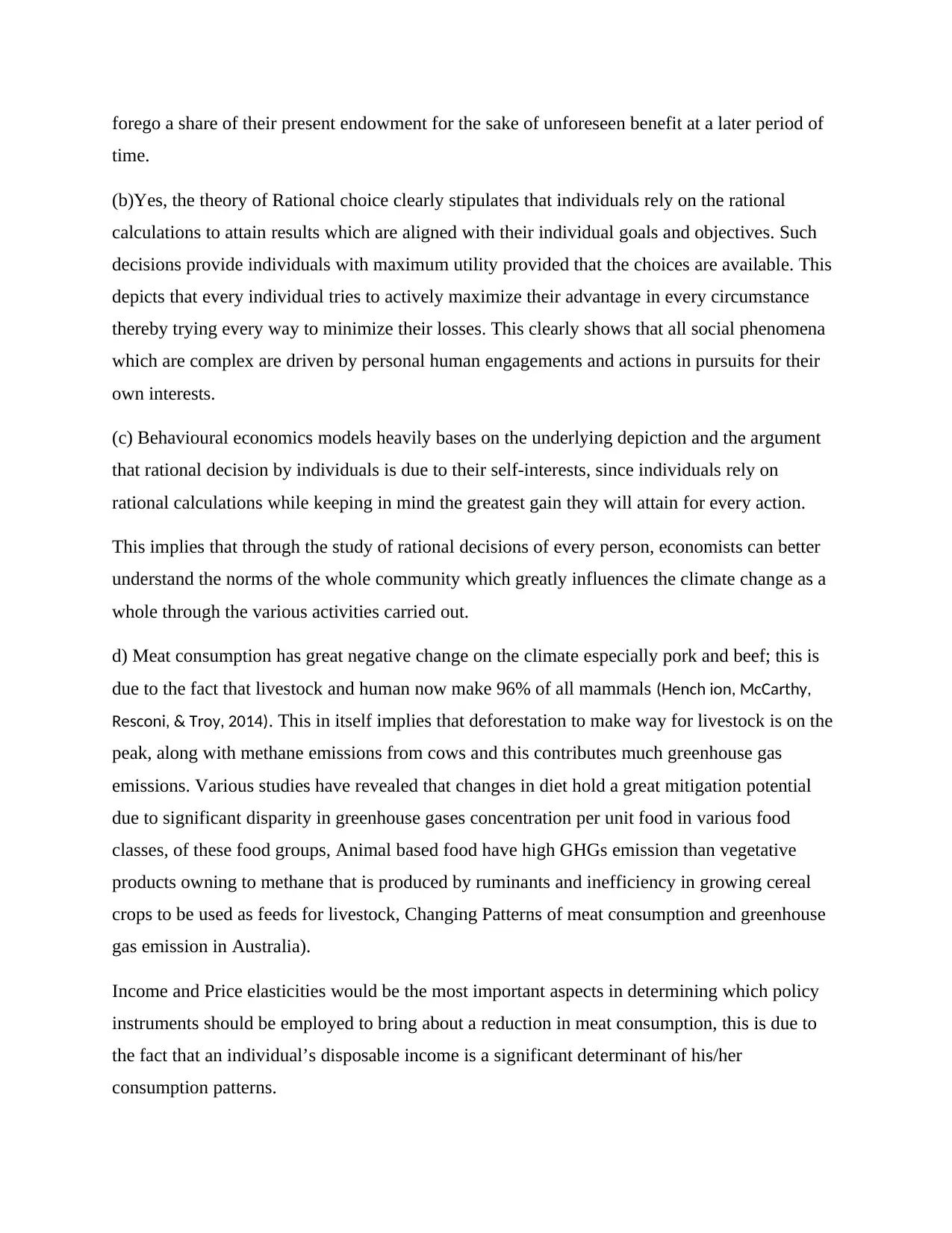
forego a share of their present endowment for the sake of unforeseen benefit at a later period of
time.
(b)Yes, the theory of Rational choice clearly stipulates that individuals rely on the rational
calculations to attain results which are aligned with their individual goals and objectives. Such
decisions provide individuals with maximum utility provided that the choices are available. This
depicts that every individual tries to actively maximize their advantage in every circumstance
thereby trying every way to minimize their losses. This clearly shows that all social phenomena
which are complex are driven by personal human engagements and actions in pursuits for their
own interests.
(c) Behavioural economics models heavily bases on the underlying depiction and the argument
that rational decision by individuals is due to their self-interests, since individuals rely on
rational calculations while keeping in mind the greatest gain they will attain for every action.
This implies that through the study of rational decisions of every person, economists can better
understand the norms of the whole community which greatly influences the climate change as a
whole through the various activities carried out.
d) Meat consumption has great negative change on the climate especially pork and beef; this is
due to the fact that livestock and human now make 96% of all mammals (Hench ion, McCarthy,
Resconi, & Troy, 2014). This in itself implies that deforestation to make way for livestock is on the
peak, along with methane emissions from cows and this contributes much greenhouse gas
emissions. Various studies have revealed that changes in diet hold a great mitigation potential
due to significant disparity in greenhouse gases concentration per unit food in various food
classes, of these food groups, Animal based food have high GHGs emission than vegetative
products owning to methane that is produced by ruminants and inefficiency in growing cereal
crops to be used as feeds for livestock, Changing Patterns of meat consumption and greenhouse
gas emission in Australia).
Income and Price elasticities would be the most important aspects in determining which policy
instruments should be employed to bring about a reduction in meat consumption, this is due to
the fact that an individual’s disposable income is a significant determinant of his/her
consumption patterns.
time.
(b)Yes, the theory of Rational choice clearly stipulates that individuals rely on the rational
calculations to attain results which are aligned with their individual goals and objectives. Such
decisions provide individuals with maximum utility provided that the choices are available. This
depicts that every individual tries to actively maximize their advantage in every circumstance
thereby trying every way to minimize their losses. This clearly shows that all social phenomena
which are complex are driven by personal human engagements and actions in pursuits for their
own interests.
(c) Behavioural economics models heavily bases on the underlying depiction and the argument
that rational decision by individuals is due to their self-interests, since individuals rely on
rational calculations while keeping in mind the greatest gain they will attain for every action.
This implies that through the study of rational decisions of every person, economists can better
understand the norms of the whole community which greatly influences the climate change as a
whole through the various activities carried out.
d) Meat consumption has great negative change on the climate especially pork and beef; this is
due to the fact that livestock and human now make 96% of all mammals (Hench ion, McCarthy,
Resconi, & Troy, 2014). This in itself implies that deforestation to make way for livestock is on the
peak, along with methane emissions from cows and this contributes much greenhouse gas
emissions. Various studies have revealed that changes in diet hold a great mitigation potential
due to significant disparity in greenhouse gases concentration per unit food in various food
classes, of these food groups, Animal based food have high GHGs emission than vegetative
products owning to methane that is produced by ruminants and inefficiency in growing cereal
crops to be used as feeds for livestock, Changing Patterns of meat consumption and greenhouse
gas emission in Australia).
Income and Price elasticities would be the most important aspects in determining which policy
instruments should be employed to bring about a reduction in meat consumption, this is due to
the fact that an individual’s disposable income is a significant determinant of his/her
consumption patterns.
Paraphrase This Document
Need a fresh take? Get an instant paraphrase of this document with our AI Paraphraser
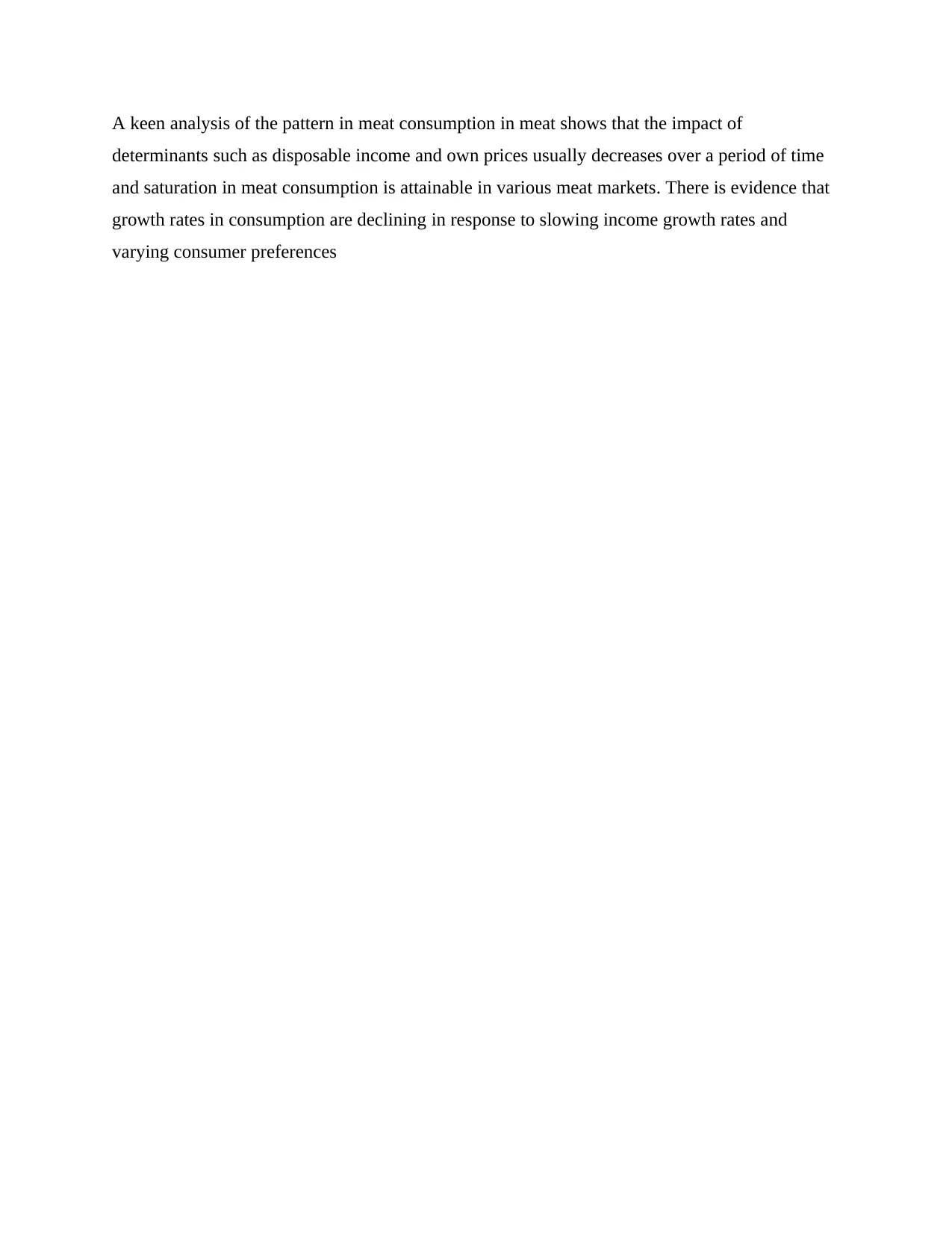
A keen analysis of the pattern in meat consumption in meat shows that the impact of
determinants such as disposable income and own prices usually decreases over a period of time
and saturation in meat consumption is attainable in various meat markets. There is evidence that
growth rates in consumption are declining in response to slowing income growth rates and
varying consumer preferences
determinants such as disposable income and own prices usually decreases over a period of time
and saturation in meat consumption is attainable in various meat markets. There is evidence that
growth rates in consumption are declining in response to slowing income growth rates and
varying consumer preferences
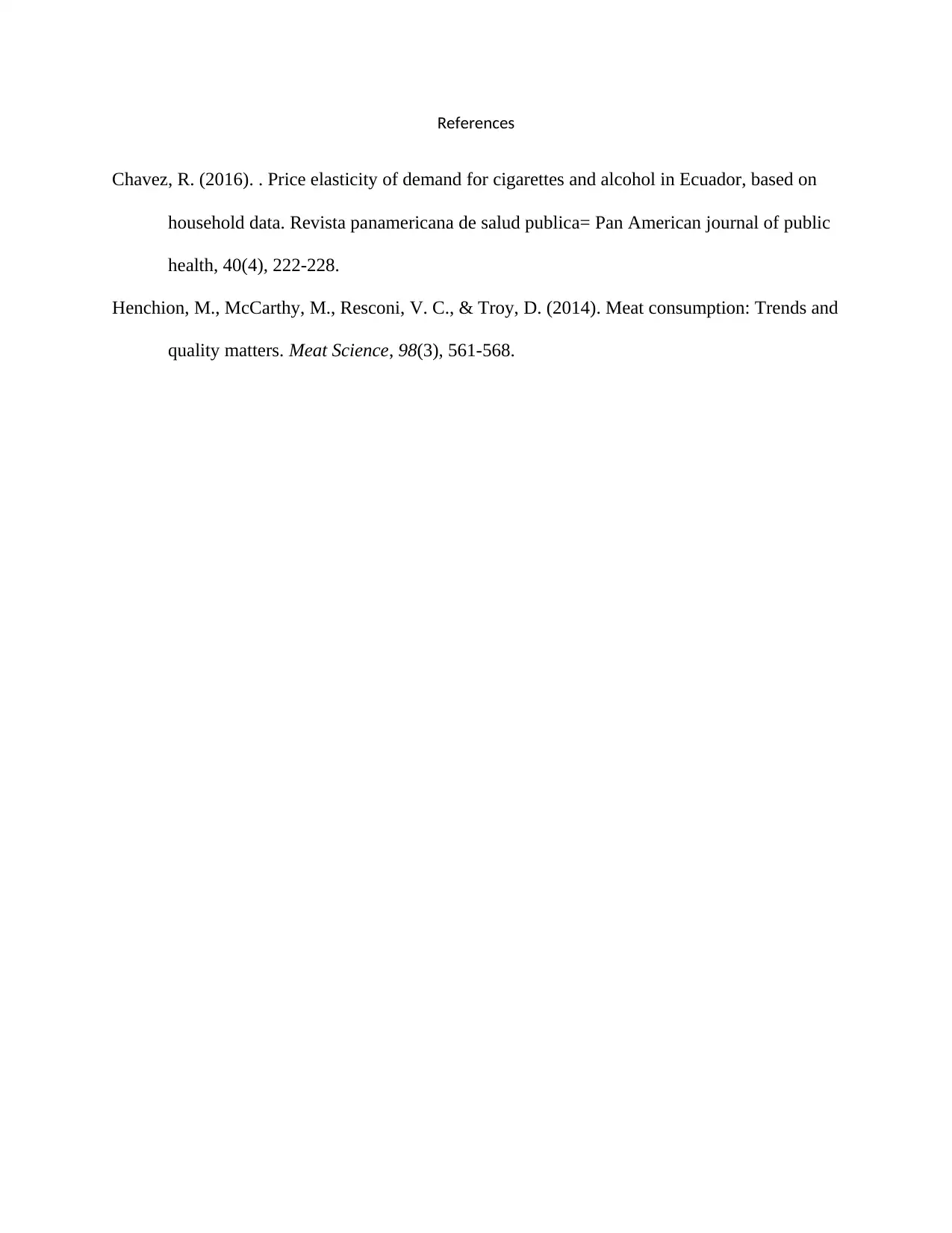
References
Chavez, R. (2016). . Price elasticity of demand for cigarettes and alcohol in Ecuador, based on
household data. Revista panamericana de salud publica= Pan American journal of public
health, 40(4), 222-228.
Henchion, M., McCarthy, M., Resconi, V. C., & Troy, D. (2014). Meat consumption: Trends and
quality matters. Meat Science, 98(3), 561-568.
Chavez, R. (2016). . Price elasticity of demand for cigarettes and alcohol in Ecuador, based on
household data. Revista panamericana de salud publica= Pan American journal of public
health, 40(4), 222-228.
Henchion, M., McCarthy, M., Resconi, V. C., & Troy, D. (2014). Meat consumption: Trends and
quality matters. Meat Science, 98(3), 561-568.
⊘ This is a preview!⊘
Do you want full access?
Subscribe today to unlock all pages.

Trusted by 1+ million students worldwide
1 out of 9
Related Documents
Your All-in-One AI-Powered Toolkit for Academic Success.
+13062052269
info@desklib.com
Available 24*7 on WhatsApp / Email
![[object Object]](/_next/static/media/star-bottom.7253800d.svg)
Unlock your academic potential
Copyright © 2020–2025 A2Z Services. All Rights Reserved. Developed and managed by ZUCOL.





